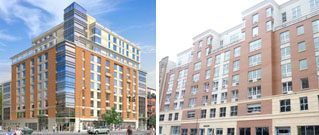Trending
Architect Hugo Subotovsky sets record straight on Adolfo Carrion scandal, talks new projects
In the wake of a scandal over whether New York-based architect Hugo Subotovsky did or did not bill former Bronx Borough President Adolfo Carrion for work on his borough home in return for backing some of the architect’s projects, Subotovsky, of Aufgang + Subotovsky, sat down with The Real Deal for a Q & A to set the record straight and discuss some of his most recent endeavors.
Carrion, the new regional director for the Department of Housing and Urban Development, was not immediately available for comment, but a review of the case by authorities was closed because of “no evidence of any wrongdoing” on Carrion’s part, Steven Reed, spokesperson for the Bronx DA said in a previously reported statement.
Subotovsky bought his firm Aufgang + Subotovsky in 1998, after the owner, a longtime colleague, passed away. About 25 people work at the company. Relatively recently completed projects include the Livmor Condos at 2131 Frederick Douglas Boulevard, Hudson 192 condos in Hudson Heights and the Boricua College Vertical Campus in the Bronx.
The Carrion accusations, Subotovsky told The Real Deal, were completely false and misguided. He elaborated on that, and spoke about the changing duties of an architect in an economy where financing is tight, specific projects he is working on and how City Planning Commissioner Amanda Burden is “leaving a legacy in New York City.”
So, you said you wanted to set the record straight about the Carrion scandal. What did you want to say?
It’s very simple. I treated him like I treat any client. He paid the bill. It was nothing other than my normal course of business.
Wasn’t there talk of him paying the bill late?
The investigation resulted in no wrong-doing. He actually paid more than a normal client because I had to do a re-inspection. I wouldn’t normally charge for that, but since he was a public official, I wanted to be safe.
How has the market been affecting your business?
It’s amazing how things change and switch. In 2008, 90 percent of our work was affordable housing. Now it’s 50 percent affordable, 50 percent market-rate. The process of getting a building off the ground used to take six months; now it’s close to three years because of shrinking subsidy [from banks]. With new condos… the only problem is with financing.
Can you talk more specifically about projects you’re working on?
[4469 Broadway at 193rd Street] is an existing building [in Manhattan being erected by Jackson Development]. Work stopped in 2009 so only part of the structure is there. It was designed as a condo, but now it’s going rental. The design changed because of that. Some amenities were taken away.
[At an undisclosed development site on 112th Street and Second Avenue in East Harlem] the developer wants to design it as a rental, but keep in mind that it might go condo. You have to be always thinking, “would that be a good fit for the condo market in the future?” It’s a fine balance. I don’t know how long it will stay rental. I was told two years. It’s about how to create flexible projects that are adaptable to the other side of the market.
Can you talk about some of your public sector work?
Public sector work is different [than private sector work]… you have no input so you just listen. You have to please your clients plus all agencies involved. We have worked on a project where Landmarks [Preservation] Commission and New York State Energy Research and Development Authority were involved and when the conversation got to the window specifications, it was fun to just sit back and listen. Dealing with [the] City Planning Commission is different. Amanda Burden made architecture a big part of the zoning process; she’s leaving a legacy in New York City [Burden has been City Planning Commission chair since 2002].





